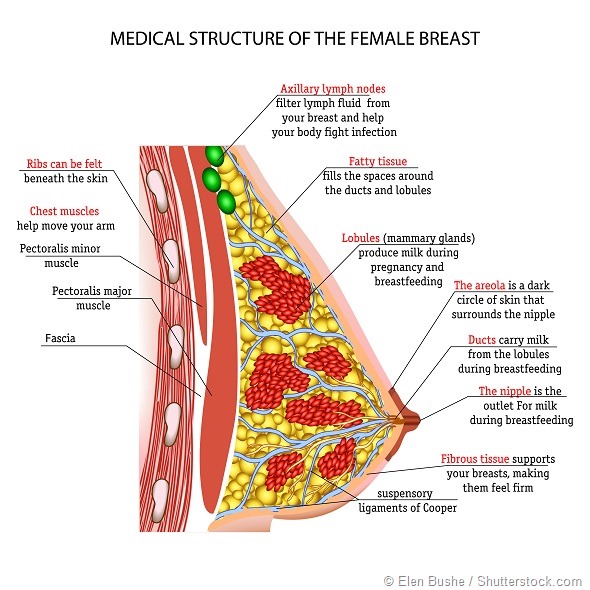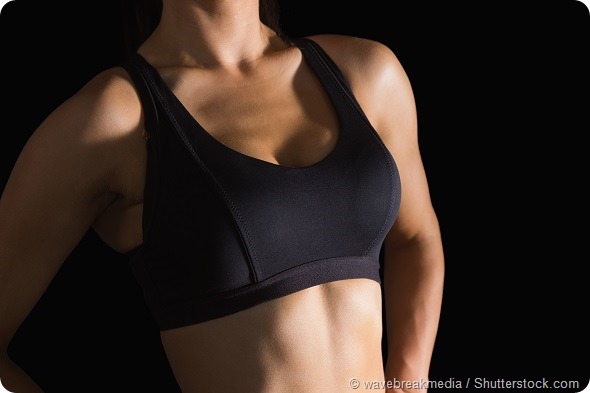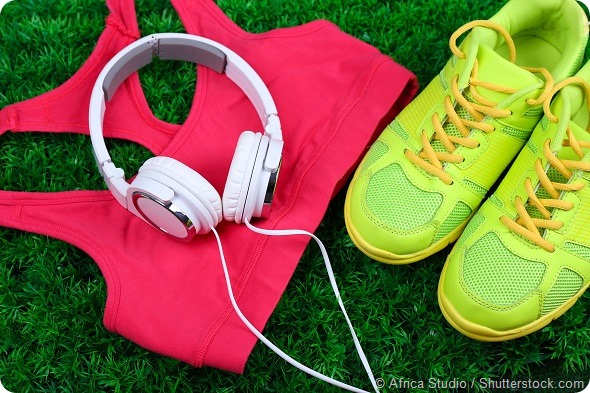How important is it to wear a sports bra when exercising?
Very important. The breast itself doesn't contain any muscles and the only 2 supporting structures are the skin and the Cooper’s ligaments. Both of those structures are quite weak mechanically so they're not able to hold the breast in place firmly.
When we move, the breast moves independently and that independent movement has a number of negative consequences.
Our research, for the last 10 years, has revolved around investigating those negative consequences and how we can develop products, change habits, improve health to try to reduce some of those negative consequences.

What damage can be caused to breasts if they are not properly supported during exercise?
We've seen independent breast movement of up to 21 centimeters, which is a substantial amount of movement. On average, you're looking at about 15 centimeters of independent movement when the average breast sized woman exercises, such as jogging or an aerobics-type activity.
The breast itself in the UK averages about half a kilogram per breast. If you imagine you've got that mass moving quite considerably, if it's not supported when a woman is exercising, that independent movement has negative consequences.
Firstly, one of the big negative consequences is that it hurts. Many women will experience discomfort in the breast, or breast pain as a result of this movement of the mass of the breast and the pain is thought to be linked to stretching on the supporting structures including stretching the skin, tension on the skin, tension on the Coopers ligaments.
We also know that around half of women in the UK experience breast pain on a monthly basis, so breast pain linked to their menstrual cycle, which is thought to be related to hormonal changes within the breast. 15% of the population in the UK also experience constant breast pain, which is nothing to do with the movement of the breast, they're just in constant pain in their breast.
If you have half the population who are experiencing pain on a monthly basis, 15% who are experiencing constant pain and then we're trying to get women to exercise, on top of that. You're almost getting a double, a compounded effect of movement-related breast pain and clinical breast pain we call it.
The breast pain side of things is a really important negative consequence linked to that independent movement of the breast. Another negative consequence is that, with the breast weighing about half a kilogram, if we keep stretching and stretching those weak supporting structures, eventually they don't return to their original position and the breast sags and we know that that happens with ligamentous tissue.
If we take Cooper’s ligaments for example, we know with ligamentous tissue elsewhere in the human body, if we stretch and stretch it, eventually it elongates and that's known as ligament creep.
We know that the same thing happens with the skin, that the skin has a stretch response and if we stretch it beyond about 80% of its original length, it doesn't return to its original length and we see damage occurring to the skin.
We're doing quite a lot of work at the moment looking at skin strain limits in breast skin, to understand the potential risks of exercising without appropriate breast support.
Another negative consequence, and another area that we're doing a lot of work in, is that the mass moving on your chest can actually change the way that you move. It can have a negative effect on your sporting performance.
I've had 3 PhD students complete their entire PhD's looking at the effect of the movement of the breast on various sporting performance and how effective sports bras can be at improving or reducing that negative consequence.
We know that if the mass moves around actually we see increases in muscle activity in the upper body, where the upper body is trying to support the breast naturally. When those muscles are working harder to support the breast, they’re not working harder to do your sporting activity.
We also see changes in breathing frequency related to the movement of the breast. We see differences in running gait, differences in the way that we might perform various sports linked to that independent movement.
The final negative consequence is the psychological aspect. The fact that if your breast bounce, it can be a deterrent to exercise. We did a study, published last year, which reported the breast was a barrier to exercise for 17% of women. 17% of women actively avoided exercise due to reasons related to the breast. It could be that they were embarrassed, that it hurt, that they couldn't find the right sports bra. It was a number of different reasons but 17% of the female population in the UK is quite a high statistic.

Can exercise without adequate support cause long-lasting damage to the breasts?
Yes. We're doing research looking at skin strain, with the skin of the breast being one of the key supporting structures. For some women it might be the primary supporting structure. We know, if you take things like stretch marks for example, stretch marks are where the skin has been stretched beyond its elastic limit and it's actually scar tissue that forms.
We've had many patients in our lab who have had stretch marks on their breasts as a result of that stretching of the skin beyond its elastic limit. That's irreparable and the same thing with the Coopers ligaments, once they stretch, you can't reel them back in. You can't get them any shorter.
From a damage perspective, our hypothesis is that you could be doing significant damage to the supporting structures of the breast unless you reduce that independent movement to a safe limit.
Does breast tissue age at a faster rate to other tissues?
Well, certainly from a gravity perspective. If you take the position of the breast and the fact that it's freely hanging on most sides of the breast, there's only one bit that attaches it to the body, and it can be of a considerable mass.
When we look at gravity, we know that one of the key things that influences the effect of gravity is mass. If you have a mass that's suspended reasonably freely and subject to gravity then it is likely to migrate inferiorly, which essentially means sag or move downwards.
So breasts are likely to do that quicker than other parts of the body just because of their structure, because of the shape and because they have very weak, natural support within.
What advice would you give to women looking to choose an appropriate sports bra?
Don’t assume there isn’t a solution out there for you. If you haven't assessed the sports bra market recently, I would recommend that you do. There's been a huge increase in the number of brands, the sizes, the styles and the range of sports bras available. The market has seen a huge growth over the last 10 years. There's some really good products out there, there's some good solutions.
In the UK, we're really lucky because our size range is way ahead of anywhere else in the world. There are sports bars available on most high streets in the UK that go up to a 40HH and that is a huge size range that's stocked.
Another bit of advice is there's no such thing as the ultimate sports bra. What works well for me, might not work well for someone else, or definitely won't work well for someone else because it's so dependent on your anatomical structure, your shape, the density of your breasts, the way your breasts sit.
It also depends on the type of activity that you're going to do, what you want the sports bra for, what issues you have with bras. It's dependent on your bra history as well, we've had many women into our laboratory and we fitted them in the right size sports bra and they said, "I'd never wear this, this doesn't fit me." That's just because they're not used to it.
My advice is, shop for your first sports bra in-store, don't buy online because it's very difficult to get it right online but once you know what you want then obviously repeat ordering online is great. Go in-store, try it on and allow yourself plenty of time. It's going to take you an hour, an hour and a half maybe because there's so much choice now. You want to try on different styles.
Please can you outline the main different styles of sports bra and how they work?
There's 3 key styles of sports bras that exist that work in 3 different fundamental ways from a physics perspective.
There's encapsulating sports bras that work like an everyday bra. They encapsulate the left and the right breast separately, hold them in place. They don't compress the breast tissue at all, they are a full cup that cups each breast separately. They can work very well for larger breasted women, they aren't that stretchy so they can provide some really good motion control to hold the breast in place. Again, they come in a range of sizes.
Then there's compression sports bras that work by squashing the breast tissue towards the chest wall, this re-positions the center of mass of the breast closer to the chest wall and that reduces the force acting through the breast and therefore reduces movement of the breast. That's the fundamental principle of how they work.
Whereas the encapsulation bras can be more rigid and they just hold the breast in place; the compression bras re-position the tissue, the mass, closer to the chest wall and that reduces the movement.
The downside of the compression sports bras is that by compressing the breast tissue and so it squishes in-between the breasts, under the arm, it moves up, it'll go anywhere it can and because of that, the products of themselves have to be much more elasticized because they have to allow the tissue to go somewhere and because they're more elasticized they don't hold the breast in place. Although you've squashed and you've moved it closer to the chest wall, it can still move around but it moves around closer to the chest wall.
We tend to recommend compression sports bras for smaller breasted women and when I'm talking about smaller breasted women I'm really referring to anything under a D cup, because the D cup is the average size in the UK. Those compression sports bars tends to be things like the crop top, put on over your head type products.
The 3rd type of product is called the combination sports bra and it's a combination of encapsulation and compression. They tend to have molded cups on the inside and then a compression overlay. You mold the breasts, the molded cups, and then squash them.
People often think, "Well surely the combination is best because it contains both elements," but that's not necessarily the case. You can get some great encapsulation bras, you can get some great combination bras and for smaller breasted women you can get some great compression bras. It's so individual, it depends what you want the bra for as I was saying, all of those factors that might influence how effective the bra is for you.
How often would you recommend updating a sports bra?
Predominantly the life of a sports bra is determined by how you wash it. It's not determined by use, how often you wear it or breast size or anything like that. My recommendation is always follow manufacturer's guidelines.
Don't tumble dry sports bras because that really reduces the elasticity within the product. My advice is, if you're doing enough exercise that you need to replace your shoes, your trainers, then you probably need to replace your sports bra as well.

Other than wearing an appropriate sports bra, is there anything else you can do to reduce breast damage when exercising?
The type of exercise that you do affects the load through the breast, so it affects the amount of force through the breast. Lower impact activities include like Pilates, yoga, cycling and swimming.
We have a lot of women into our laboratory who experienced significant breast pain and as a result of their breast pain, they're not able to exercise. We very often will recommend water-based activities because the buoyancy of the water provides some support to the breast.
You're able to get a good workout in water. You don't necessarily have to swim, think water running, for example, in water is a great alternative to land-based running. It's still quite a physiologically demanding workout but the water supports the breasts.
Choosing the type of activity is important. I’d like to encourage women to still remain active and don't let that be a barrier to exercise because there are alternative exercises that you could do that wouldn't put as much load through the breast.
Are there any particular requirements for people with breast implants?
When you have a breast implant, it’s essentially a foreign body that's inserted into the human body and so the response of the human body is to form a scar tissue envelope around the implant itself.
Scar tissue actually tends to be stronger than the original tissue so you get quite a strong, firm envelope surrounding the implant. When you see women who have had an implant that's positioned on top of the muscle, the implant is quite pert, so it stays in place and it doesn't move as much. The reason for that is this scar tissue envelope that holds it nicely in place.
Some surgeons recommend using a sports bra all the time for women who have had breast augmentation. We certainly recommend it in this country during the recovery process and that's so that this scar tissue envelope can adhere to the implant until it’s fully healed.
I would still recommend for any woman to use a sports bra when they're undertaking physical activity, when there's a chance that the breast might move excessively then the amount of support that you use, whether you've had a surgical procedure or not, is really important.
What commons myths would you like to dispel about breast health?
I guess one that I would like to advocate is the importance of an appropriately fitted bra. Many women are wearing the wrong sized bra. This is a problem.
We spend a lot of time working with manufacturers to develop great product, however, if they don't fit, they're not going to function appropriately.
There's a lot of myths regarding perfect size and shape of breasts, which I get frustrated about. Obviously there is no such thing. We do workshops with school girls and we talk about these myths associated with the breasts. One fact that they always find very interesting is that 97% of women have one breast bigger than the other.
Did You Know #15 - Breast Health from University of Portsmouth on Vimeo.
A myth that breasts should be perfectly symmetrical is a myth and the majority of women have one breast bigger than the other. Interestingly, it's usually the left breast that's bigger, so for 62% of the population, the left breast is bigger than the right breast.
Our interest in this area originated from how perceptions of the breast, breast development, breast size, breast shape, might influence girls body image and how that might affect their self-esteem. We were really surprised by the high percentage of girls that had an issue with their breasts. I think it was 87% had at least one concern about their breast and we know from other literature that that has a negative effect to their body image and to their self-esteem.
Please can you give an overview of your current research on the biomechanics of the breast?
Yes, our core business is breast bio-mechanics. We've been undertaking research on the bio-mechanics of the breast for nearly 11 years now. We have many different strands of research that all link to the bio-mechanics of the breast. That's our core function and then we use our understanding of the bio-mechanics of the breast to inform other areas of research.
For example, we do a lot of research on how the breast changes throughout the life cycle. Looking at the changes in the breast during puberty, as breasts develop, during pregnancy, during menopause, during the aging process, that's all linked back to the bio-mechanics of the breast.
We do a lot of research on breast pain but we look at breast pain from a bio-mechanical perspective. We're doing a big study at the moment with the local hospital looking at mechanical support, buying a good bra, the right bra for you. We're looking at how effective mechanical support can be at reducing clinical breast pain, so not movement related breast pain but clinical breast pain.
We're doing other research to look at things like breast strain, trying to understand how much damage we might be doing to our breast. We’re looking at breast bio-mechanics in different sporting situations, in swimming, in horse riding, in Pilates, yoga, loads of different types of activities.
We're doing other research, looking more at the mechanical properties of the tissue itself. We're doing research on 3D scanning work, so looking at different breast compositions and how that might affect the position, the shape, the bio-mechanics of the breast, so how it moves.
We'd like to do some research looking more at breast density and how breast density might link to the bio-mechanics of the breast. We don't have the equipment to be able to assess breast density at the university so we'd love to find a partner who's able to assess breast density and then we'll assess the bio-mechanics and then we can look at the relationship between the two.
Please can you outline the education project you’re involved with?
One of our key objectives is to raise awareness of this area and we believe that a good starting point is to do that with school girls and so we have a breast education project that's ongoing at the moment.
The breast education project identified that the breast is a real concern for school girls with 87% wanting to know more about the breast. 46% said that the breast put them off exercising. 15% of school girls said that their breasts were too big for them to exercise.
With the breast education project, we're not just focusing on the sports side of things but just in general, providing information to school girls on breast health, we believe, and the results of our survey in the area suggests that this is crucial and currently in the UK there's no compulsory breast education.
There's actually no breast education extra-curricular courses offered and so the next phase of the education project is to develop resources, online resources, that teachers can freely download and they can use that to put together a class on breast health, breast education.
We're at the point at the moment of developing those resources, we don't have any sponsor for that project so the approach that we're quite interested in looking for donations from businesses as a consortium approach to that area. We believe that this is a really important part of what we do: dissemination and raising awareness.
Where can readers find more information?
www.port.ac.uk/breastresearch
About Professor Joanna Scurr
Joanna Scurr, PhD is Professor in Biomechanics, the biomechanics field leader and Head of the Research Group in Breast Health. She completed her undergraduate and postgraduate degrees at the University of Chichester (1999). She is a BASES accredited Sport and Exercise Scientist and a fellow of BASES.
As a Professor her role focuses mainly on research having taught on many undergraduate and Master's level Biomechanics modules in the past. She is unit coordinator for the MSc Applied Biomechanics module and supervises many undergraduate, MRes and Postgraduate research students.